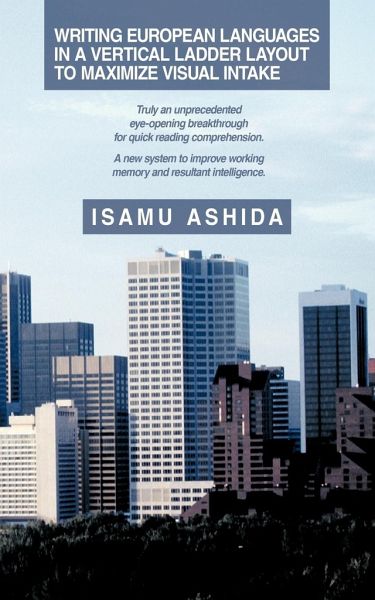
Writing European Languages in a Vertical Ladder Layout to Maximize Visual Intake
Truly an Unprecedented Eye-Opening Breakthrough for Quick Reading Co
Versandkostenfrei!
Versandfertig in 1-2 Wochen
19,99 €
inkl. MwSt.

PAYBACK Punkte
10 °P sammeln!
This book attempts to explore "Umami" in reading alphabetic languages. In this exploration each European language will reappear as "Umami English (UE)," "Umami German (UG)," "Umami French (UF)," "Umami Italian UI)," and so forth. What exactly is Umami? It is a loanword from Japanese. It means a primary taste in food, so pleasant and savory that it makes those taste-sensitive people happy. Here I emphasize that Umami exists not only in food but almost on all aspects of life. All we need is just to ooze it out from whatever involved and make better use of it in the course of life. Then what is U...
This book attempts to explore "Umami" in reading alphabetic languages. In this exploration each European language will reappear as "Umami English (UE)," "Umami German (UG)," "Umami French (UF)," "Umami Italian UI)," and so forth. What exactly is Umami? It is a loanword from Japanese. It means a primary taste in food, so pleasant and savory that it makes those taste-sensitive people happy. Here I emphasize that Umami exists not only in food but almost on all aspects of life. All we need is just to ooze it out from whatever involved and make better use of it in the course of life. Then what is Umami in reading? It means gained cognitive sense to enjoy the greater magnitude of reading pleasure. It is visually enhanced reading comprehension with incredible long retention of what is read as a context. It is the eye-catching layout of sentences that makes Umami in reading occur. Umami is speed, and it only exists in reading by the eye. For alphabet sentences where non-verbal, visual reading is very limited, if any, to read quickly at a lightening-speed never occurs. One exception is "Photoreading" by Paul R. Scheele who claims 6000-words-per-minute reading is possible, which I call movie camera shooting where there is definitely no Umami in reading.














